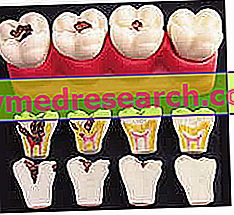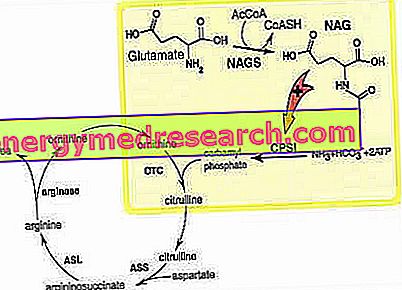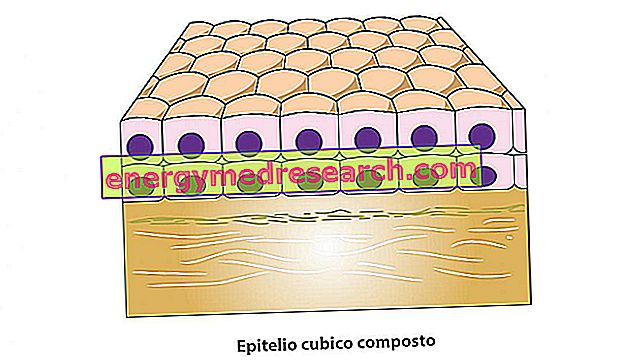Caries are not all the same. There are in fact numerous types of cariogenic processes, distinguished on the basis of:
- Type of injury
- Evolution of caries
- Location and form of infection
- Depth of damage

Depth of caries
Before proceeding with the treatment for carious tooth care, the dentist must check the depth of the caries, and then act accordingly. The extent of each caries is evaluated using a scale of values ranging from 1 to 4.
- Grade 1 caries: the cariogenic process does not go beyond enamel. Caries is superficial and therefore easily repairable through a simple filling.
- Grade 2 caries : dental infection, which originates from enamel anyway, has also affected superficial or deep dentin. Even at this stage, the filling can completely restore the tooth.
- Degree caries: caries has evolved into pulpitis. The infection, which also involved the dental pulp, cannot be treated with a simple filling: in these circumstances, the most indicated intervention is devitalization. If the tooth involved is a third molar, the recommended intervention is instead the extraction of the wisdom tooth.
- Degree caries 4 : the most serious type of caries ever. The tooth has necrotic pulp with evident involvement of the periodontal tissues of the root apex. Grade 4 caries is included in the list of periapical diseases.
Types of caries
It is possible to relate caries according to some of their particular characteristics. For this purpose, we distinguish:
- Acute caries (rapid evolution)
- Chronic caries (slow evolution)
- Dry or arrested caries
- Recurrent and secondary caries
- Central caries
- Senile caries (or cement)
- Caries from acid vapors
- Caries of sugar workers
- Caries from ionizing radiation
Acute and chronic caries
These two types of caries are distinguished based on the temporal duration of the respective evolution.
The acute term is used improperly here, since the progression of the infectious process lasts some months (at least six). A cavity is defined as chronic when the process is completed within a couple of years.
FEATURES | CARIES OF ACUTE TYPE | CHRONIC TYPE OF CARIES |
Evolution | Quick (a few months) | Slow (2 years) |
External cavity of the cavity | Small | ample |
Inside the tooth ... | The area of soft tissue is deep and extensive | The area of softened tissue is not very extensive and exposed to the oral environment |
Characteristics of the enamel | The enamel altered by caries dominates a large mass of softened dentin | A modest amount of altered enamel dominates the margins of the infected area |
Appearance of enamel and dentin | Chalky enamel and pale yellow dentin | Caries have a yellowish, brown or black pigmentation |
Generality | The patient complains of a marked dentinal hypersensitivity, a clear symptom that suggests an imminent inflammation of the pulp (pulpitis) | The dentinal sensitivity is not particularly pronounced. The pulpitis, if manifested, tends to appear belatedly |
Dry caries
For "dry caries" we mean a caries arrested over time: this means that the infectious process is blocked without creating further damage to the other tissues of the tooth. The arrested variant is therefore a type of caries that does not create damage in the short term. However, some dentists advise proceeding with a filling procedure since the lesion, while not damaging the tooth from a functional point of view, can compromise its aesthetics. In fact, even dry caries has a very small black dot with a very hard surface.
However, we would like to remind you that a dry caries can become active again at any time: for this reason, it is strongly recommended to always keep the injury under control.
Recurrent caries ( recurrent caries ) and secondary
Sometimes the terms relapsing and secondary - referring to caries - are improperly used as synonyms. In reality, the two types of caries are different.
- Carious lesions can recur when not carefully filled. This type of caries is the recurrence of a badly treated carious infection, which can appear above (or on the margins) of a pre-existing filling.
- Normally, the term secondary indicates a caries resulting from a new carious lesion. The neo-infection manifests itself in the vicinity of a successful filling, whose caries of origin had been completely eliminated. In other words, secondary caries appears in the same clogged tooth, without however having any relation to the previous caries.
Central caries
The central one is a very particular type of caries, which grows in the opposite direction compared to the "traditional" caries.
When an infection reaches the dental pulp causing gangrene, the walls of the pulp canal are exposed in the oral environment. The central caries begins on these surfaces and propagates from the dentine tubules towards the external surface (reverse direction compared to the classic carious process). As the lesion advances, the walls of the root are gradually thinned and destroyed: in doing so, we witness a migration towards the outside of the same root that sometimes disappears after a few years.
Senile caries
Also known as cement or root caries, senile caries begin in exposed dental collars as a result of a gum recession. However, the carious process manifests itself around these collars without affecting the enamel: since the enamel does not have to be pierced, the bacteria are facilitated in their unstoppable destructive process. Not finding impediments, the microorganisms can easily reach the dental pulp, creating greater damage (pulpits) and in a short time.
Caries from acid vapors
This type of caries is a typical lesion of individuals who, for work reasons, are forced to remain constantly in contact with strong acid vapors. It has been observed that, a few weeks after exposure, these workers' teeth are targeted by infections of all kinds, including tooth decay. The carious lesions can be multiple, extensive, diffuse, fragile, pigmented, soft or extremely sensitive. If not accurately treated, these dental infections can degenerate, leading to pulpits and tooth loss.
Caries of sugar workers
Similar to the previous case, this type of tooth decay is typical of pastry chefs, sugar bowls and all those workers who for professional reasons are constantly in contact with sugar and flour dust. By depositing on the collars of the teeth, these powders favor the onset of caries, often accompanied by annoying gingivitis.
Caries from ionizing radiation
These are extensive caries processes with rapid evolution. These caries tend to occur after a few days or some years from a treatment for the treatment of oral cancer. This type of carious lesions can cause tooth loss, pulpits or pulp fibrosis. Caries due to ionizing radiation can degenerate: granulomas and osteomyelitis cannot be missing among the complications of dental infection.
These particular diseases are often considered different from other types of dental caries.



